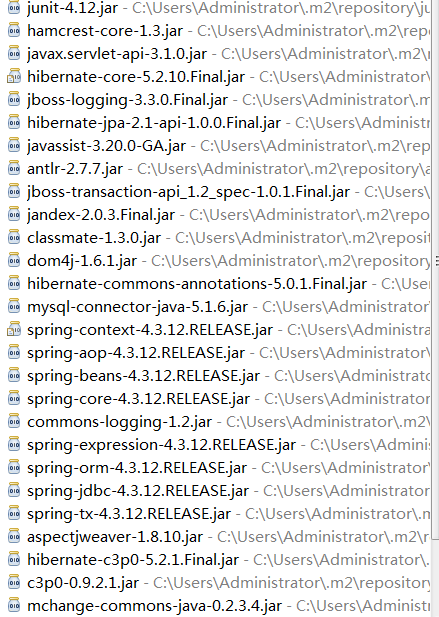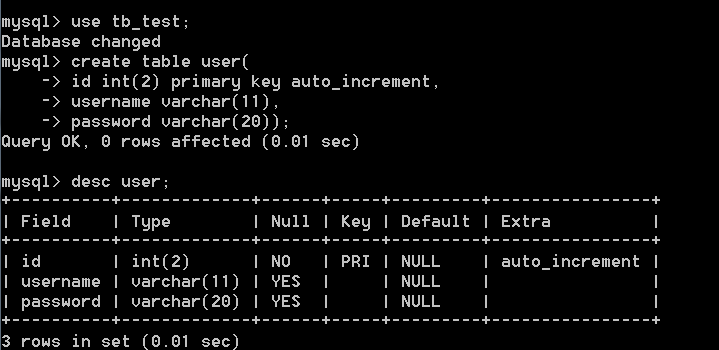I.
If you don't have a basic hibernate foundation, you can click here - ---->. ORM - Hibernate Initial Demo (Invincible Details)
I won't go into details here.
Two.
The hibernat.cfg.xml file is an important configuration file in Hibernate. When Spring and Hibernate are integrated, the configuration information in the hibernate.cfg.xml file can be educated to manage Spring.
So you can choose whether to use the hibernate.cfg.xml file or not.
Here we will explain the integration of Spring and Hibernate by using the hibernate.cfg.xml file
Before explaining the integration of Spring and Hibernate, we first need to understand three important objects, which are as follows:
1.HibernateTemplate: session equivalent to Hibernate can directly manipulate PO classes, depending on SessionFactory.
2. LocalSessionFactory Bean: Get SessionFactory.
3. Hibernate Transaction Manager: Hibernate's event manager.
3. Implementation code:
The jar package required for the entire project:

1. Integrate Spring with hibernate.cfg.xml file.
First, create a user table:

2. Establishing User Classes
public class User {
private Integer id; //User id
private String username; //User name
private String password; //User password
public Integer getId() {
return id;
}
public void setId(Integer id) {
this.id = id;
}
public String getUsername() {
return username;
}
public void setUsername(String username) {
this.username = username;
}
public String getPassword() {
return password;
}
public void setPassword(String password) {
this.password = password;
}
@Override
public String toString() {
return "User [id=" + id + ", username=" + username + ", password=" + password + "]";
}
}
3. Write the corresponding User.hbm.xml
<?xml version="1.0" encoding="UTF-8"?>
<!DOCTYPE hibernate-mapping PUBLIC
"-//Hibernate/Hibernate Mapping DTD 3.0//EN"
"http://www.hibernate.org/dtd/hibernate-mapping-3.0.dtd">
<hibernate-mapping>
<! - name represents the entity class name, table represents the table name - >.
<class name="com.hck.entity.User" table="user">
<! -- name = ID represents the field in the table table table - > attribute column=id in the user class
<id name="id" column="id">
<! - Primary Key Generation Strategy - >
<generator class="native"/>
</id>
<! - Other attributes are mapped using property tags - >.
<property name="username" column="username" type="string"/>
<property name="password" column="password" type="string"/>
</class>
</hibernate-mapping>
4. Write UserDao interface
public interface UserDao {
public void save(User user); //Add user
public void update(User user); //Update user
public void delete(User user); //delete user
public User findById(Integer id); //Searching User Data Based on User id
public List<User> findAll(); //Return all user data
}
5. Write interface implementation class: UserDaoImpl
//Open Annotation Mode, which is equivalent to spring
//<bean name="userDao" class="com.hck.dao.impl.UserDaoImpl"/>
@Repository("userDao")
public class UserDaoImpl implements UserDao {
//Dependency injection
@Autowired
private HibernateTemplate hibernateTemplate;
//Insert operation
public void save(User user) {
hibernateTemplate.save(user);
}
//update operation
public void update(User user) {
hibernateTemplate.update(user);
}
//Delete operation
public void delete(User user) {
hibernateTemplate.delete(user);
}
//Finding Users Based on ID
public User findById(Integer id) {
return hibernateTemplate.get(User.class, id);
}
//Return all user data
@SuppressWarnings("unchecked")
public List<User> findAll() {
return (List<User>) hibernateTemplate.find("from User");
}
}
6. Writing UserService Interface
public interface UserService { public void save(User user); //Add user public void update(User user); //Update user public void delete(User user); //delete user public User findById(Integer id); //According to users id Finding User Data public List<User> findAll(); //Return all user data }
7. Write UserServiceImpl class
//Open Annotation Mode, which is equivalent to spring
//<bean name="userService" class="com.hck.service.impl.UserServiceImpl"/>
@Service("userService")
public class UserServiceImpl implements UserService {
//Dependency injection
@Autowired
private UserDao userDao;
//insert data
public void save(User user) {
userDao.save(user);
}
//Update data
public void update(User user) {
userDao.update(user);
}
//Delete data
public void delete(User user) {
userDao.delete(user);
}
//Search for users based on id
public User findById(Integer id) {
return userDao.findById(id);
}
//Return all user information
public List<User> findAll() {
return userDao.findAll();
}
}
8. Write the core configuration file hibernate.cfg.xml
<?xml version="1.0" encoding="UTF-8"?>
<!DOCTYPE hibernate-configuration PUBLIC
"-//Hibernate/Hibernate Configuration DTD 3.0//EN"
"http://www.hibernate.org/dtd/hibernate-configuration-3.0.dtd">
<hibernate-configuration>
<session-factory>
<!--Designated dialect -->
<property name="hibernate.dialect">
org.hibernate.dialect.MySQLDialect
</property>
<!-- Database Driver -->
<property name="hibernate.connection.driver_class">com.mysql.jdbc.Driver</property>
<!-- Connecting database url -->
<property name="hibernate.connection.url">jdbc:mysql://localhost:3306/tb_test</property>
<!-- Database username -->
<property name="hibernate.connection.username">root</property>
<!-- Database password -->
<property name="hibernate.connection.password">123456</property>
<!-- Other configurations -->
<!-- display sql Sentence -->
<property name="show_sql">true</property>
<!-- To configure c3p0 -->
<property name="hibernate.connection.provider_class">org.hibernate.c3p0.internal.C3P0ConnectionProvider</property>
<!-- Used to correlate hbm configuration file -->
<!-- <mapping resource="com/hck/entity/Customer.hbm.xml"/> -->
<mapping resource="com/hck/entity/User.hbm.xml"/>
</session-factory>
</hibernate-configuration>
9. Write Spring's configuration file, applicationContext.xml, and place it in the src directory as well.
<?xml version="1.0" encoding="UTF-8"?>
<beans xmlns="http://www.springframework.org/schema/beans"
xmlns:xsi="http://www.w3.org/2001/XMLSchema-instance"
xmlns:context="http://www.springframework.org/schema/context"
xmlns:aop="http://www.springframework.org/schema/aop"
xmlns:tx="http://www.springframework.org/schema/tx"
xsi:schemaLocation="http://www.springframework.org/schema/beans
http://www.springframework.org/schema/beans/spring-beans.xsd
http://www.springframework.org/schema/aop
http://www.springframework.org/schema/aop/spring-aop-4.3.xsd
http://www.springframework.org/schema/tx
http://www.springframework.org/schema/tx/spring-tx-4.3.xsd
http://www.springframework.org/schema/context
http://www.springframework.org/schema/context/spring-context-4.3.xsd">
<!-- Open notes -->
<context:annotation-config/>
<!-- 1.To configure sessionFactory -->
<bean id="sessionFactory" class="org.springframework.orm.hibernate5.LocalSessionFactoryBean">
<!-- Load Hibernate Core Profile -->
<property name="configLocation" value="classpath:hibernate.cfg.xml"/>
</bean>
<!-- 2.To configure Hibernate Template -->
<bean id="hibernateTemplate" class="org.springframework.orm.hibernate5.HibernateTemplate">
<!-- Acquired through factories Session,operation PO class -->
<property name="sessionFactory" ref="sessionFactory"/>
</bean>
<!-- transaction management -->
<!-- #1 Transaction Manager is the platform, Spring tools are generated, depending on the use of persistent solutions - > 1.
<bean id="txManager" class="org.springframework.orm.hibernate5.HibernateTransactionManager">
<property name="sessionFactory" ref="sessionFactory"/>
</bean>
<!-- #2 Notification: Enhanced Transaction - >
<tx:advice id="txAdvice" transaction-manager="txManager">
<tx:attributes>
<tx:method name="save*"/>
<tx:method name="update*"/>
<tx:method name="delete*"/>
<!-- read-only -->
<tx:method name="find*" read-only="true"/>
</tx:attributes>
</tx:advice>
<!-- #3 facets: associating entry points with notification points
<aop:config>
<aop:pointcut expression="execution(* com.hck.service.*.*(..))" id="allDaoMethod" />
<aop:advisor advice-ref="txAdvice" pointcut-ref="allDaoMethod"/>
</aop:config>
<!-- Packet scan -->
<context:component-scan base-package="com.hck"/>
</beans>
Write unit test classes:
public class SpringHibernateTest {
//Defining variables
ApplicationContext ac; //Read the Spring configuration file and return the context object
UserService userService; //To receive an instance of UserService Impl
@Before
public void setUp(){
ApplicationContext ac=new ClassPathXmlApplicationContext("applicationContext.xml");
userService=(UserService) ac.getBean("userService");
}
@Test
public void insert()
{
User user=new User();
user.setUsername("Zhang San");
user.setPassword("123456");
userService.save(user);
}
@Test
public void findById()
{
User user=userService.findById(1);
System.out.println(user);
}
//Modify User Name
@Test
public void update()
{
User user=new User();
user.setId(1);
user.setUsername("Li Si");
user.setPassword("123456");
userService.update(user);
}
//Find before deleting
@Test
public void delete()
{
User user=userService.findById(1);
userService.delete(user);
}
//Find all
@Test
public void findAll()
{
List<User> list =userService.findAll();
for(User user:list)
{
System.out.println(user);
}
}
}
11) Test results:
A. Insert operation:
The sql statement printed by the console, and then go to mysql to see if the data was inserted successfully; here I insert two more information users to display and query all user information separately.


B. Query operation (query user id 1 information):

C. Update operation. (Change the username of id=1 to Lisi)

D. Delete operation, (Delete user information with id=1)


E. Query all user information

Four. Conclusion
The above is a complete integration process of Spring and Hibernate with hibernate.cfg.xml file. If you have any questions, please leave a message.~